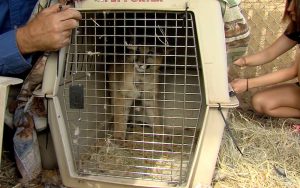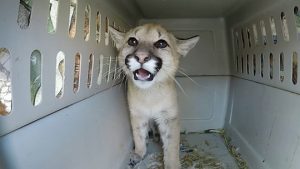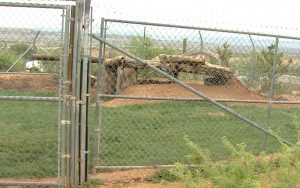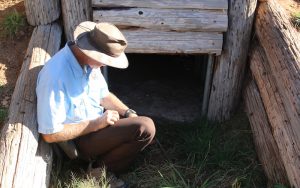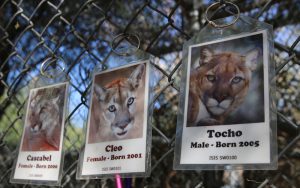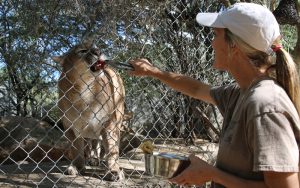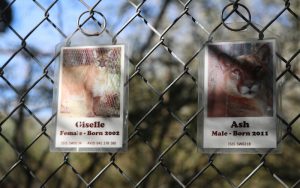- Slug: Orphan cougar cub. About 1,500 words.
- Photos available (photos and caption below)
- Map available (map in story for recommended placement; embed code below)
- Video story available
By KRISTIANA FADDOUL
Cronkite News
CAMP VERDE – A mountain lion cub clings to a tree high above ground, malnourished and frightened.
The cub is rescued, given a name, rehabilitated and moved to a new home at Out of Africa Wildlife Park, where caretakers work to soothe the trauma that still lingers months later.
Li:Bi’s journey is a story of what often happens to wildlife in Arizona that are unwillingly abandoned, left without mothers to teach them how to survive in the wild, destined for a life in captivity.
Discovering an orphan
Animal control workers found the female cub in April on the Tohono O’odham Reservation near Sells, perched in the branches of a tree where the body of her sibling, killed by dogs, lies on the ground. The tribe named the cub Li:Bi, (pronounced Libby), to reflect the spirit of the land, and turned her over to Arizona Game and Fish officials. The cub likely had been in the tree for several days: she only weighed 15 pounds, about half as much as a five- or six-month-old cub should weigh.
“This kitten would have died without intervention,” a spokeswoman for Arizona Game and Fish said at the time. “Normally we wouldn’t interfere with a mountain lion with kittens. In this case, we could tell from the weight of the kitten that was trapped that the mother was not in the picture.”
The cub’s new life began.
A veterinarian at the Arizona Game and Fish Department, Anne Justice-Allen, took the lead in the cub’s care.
“She was very thin and dehydrated,” Justice-Allen said. “She was so weak from her ordeal.”
Li:Bi needed immediate medical attention.
“After we assessed her we gave her fluids under the skin to correct her dehydration,” Justice-Allen said. “We drew some blood from her to see what kind of shape she was in physiologically to see if her kidneys had been damaged or if she had signs of infection. We took her temperature and listened to her heart and lungs.”
“Once we had recovered her from all of that, we woke her up and took her out into a large dog kennel,” she said. “Later in the day we started trying to feed her.”
Justice-Allen passed the reins to Tegan Wolf after Li:Bi’s initial medical exam. As the animal care expert at Game and Fish, Wolf led the rehabilitation efforts. Her goal was simple and specific: “My job was to keep her alive.”
“I was primary care for her, so I was in charge or making sure she ate, how much she ate, making sure she was gaining weight, any medical examinations she had to go through, and making sure she had a clean pen,” Wolf said. Later, Wolf worked to get the cub more used to people.
The team had decided early Li:Bi would need a permanent home in captivity. Releasing her back into the wild would have endangered her and any people she encountered because, although still uncomfortable with people, she was becoming too familiar with humans.
“We don’t often have opportunities to place young lions like this, and once they are brought into captivity, they cannot be replaced back into the wild,” Justice-Allen said. “They very quickly become unafraid of people, and that is just too must of a risky situation.”
After about a month at the state’s Adobe Mountain Wildlife Center, officials began discussing the cub’s future.
She needed a sanctuary. State officials put in a call to Dean Harrison, owner and operator of the Out of Africa zoo and park.
Click on location points for more information.
Finding Li:Bi a new home
“When the Arizona Game and Fish Department calls me, I know they have an issue that needs to be dealt with,” Harrison said. “Since 1986 we have been working with them and helping them with their crises in regards to not only the local animals found in Arizona, but also animals like lions and tigers and others from around the world that have come into the state.”
(Wildlife collectors and people who want exotic pets, then find out that keeping a cougar is more complicated than keeping a cat, end up with state officials and zoos. Harrison said state wildlife officials have brought more than 30 animals to Out of Africa since 1986.)
Li:Bi arrived April 30 at the zoo and wildlife center, still skittish and wary of humans.
“Li:Bi had already had one trauma, then she came across some dogs that killed her sibling, which gave her a second trauma,” Harrison said. “She was brought into captivity, which gave her a third trauma. Then she was moved here which essentially gave her a fourth trauma. So we’re working at a disadvantage with four traumas in a very young, tender life.”
Harrison, speaking of Li:Bi’s journey, said he and his team approached her transition with care.
“Taking care of an animal in her condition is somewhat like taking care of a child,” Harrison said in October. “The first thing in the morning is that you want to make sure the little one is OK. At this point she is only 11 months old, so she is still a cub.”
He said Li:Bi’s physical health has radically improved since she arrived.
“She probably weighs 65 pounds or something like that,” Harrison said. “We haven’t weighed her, because if we do that it’ll create a trauma. So whatever she weighs, she is much bigger than what she came in as.”
But emotionally, the cougar is still a work in progress.
Coaxing a cougar cub to release fear
Li:Bi’s natural instincts for moonlit activity and daytime dormancy pose another challenge to her caretakers.
Cougars are nocturnal mammals, with the majority of their activity occurring at night, Harrison said. Li:Bi learned from her mother to fear humans and keep her distance, especially during daylight.
Cougars raised in captivity are adapted to a different schedule, with activity during the day and rest in the evening, Harrison said. The schedule makes it easier for the Out of Africa workers to interact with the animal.
The Out of Africa team is working to persuade Li:Bi to switch to daylight activity. For months, she has spent most of her time tucked in a dark corner of her pen.
“Where we are right now is, she is still deciding if she is safe with us, particularly in the daytime,” Harrison said.
Harrison said he and his team have spent several months working toward switching Li:Bi’s primal instincts from the defensive side, where there is fear, to what he describes as the offensive side, where there is love.
“Everyday we come in with Li:Bi and sit with her, talk with her, let her know that she is safe,” Harrison said. “By using a soothing voice and slow movements, which are all revealing of our intent, after a while she gets a little better month by month.”
The goal is to convince Li:Bi she lives in a safe environment with bountiful food, shelter and companionship, Harrison said.
“What we would like to have happen is that we would like a couple more young cougars to come that are already familiar with and like people,” he said. “If that could be the case, Li:Bi could see them interacting with us.”
Mountain lions living in captivity
Li:Bi’s story is not unusual. The Southwest Wildlife Conservation Center in Scottsdale houses seven mountain lions with different origins, personalities and behaviors.
Kim Carr, animal caretaker at the center, refers to two “friendly” mountain lions, Tocho and Giselle, who were pets before they came to the center. Unlike Li:Bi, who huddles in her enclosure, these cougars will come to the front of their cage when called and will take food keepers offer by tongs. (Friendly does not mean “safe”: Carr said she and other employees never go inside the enclosures with cougars).
Ash, another mountain lion, lived in the wild before losing his mother to a hunter, like Li:Bi. He learned to fear human interaction, and roamed at night.
Similarly to Li:Bi, he shies away from people, only recently emerging from his sanctuary to feed during daylight, Carr said. He was transferred to the center in 2011 from a California zoo.
Carr agrees with Harrison’s belief that skittish mountain lions can be coaxed into interacting with people if their animals companions model the behavior.
Ash and the more people-familiar cougar Giselle share an enclosure. Carr believes Ash’s observation of Giselle’s interactions with the conservation center’s caretakers, relying on them for regular meals and shelter, slowly showed Ash how to override his natural instincts.
“The more social animals definitely help the shyer animals come out of their shell,” Carr said.
^__=
Embed code: <i>Click on location points for more information.</i>
<iframe src=”https://www.google.com/maps/d/u/0/embed?mid=1V8FX60cKZX9cxDdt3VbZXxZVUTk” width=”800″ height=”480″></iframe>
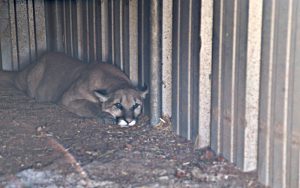

The Adobe Mountain Wildlife Center, an
extension of Arizona Game and Fish, housed
Li:Bi during her rehabilitation.
(Photo by Kristiana Faddoul/Cronkite News)
